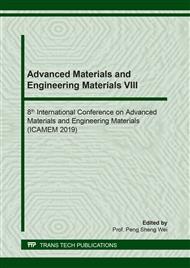[1]
W. Y. Shi, B. S. Peng, Y. Y. Guo, Synthesis of asymmetric zinc phthalocyanine with bulky diphenyl thiophenol substituents and its photovoltaic performance for dye-sensitized solar cells, J. Photochem. Photobiol. A: Chem. 321 (2016) 248-256.
DOI: 10.1016/j.jphotochem.2016.02.009
Google Scholar
[2]
P. T. Zhang, Z. Q. Hu, Y. Wang, Enhanced photovoltaic properties of dye-sensitized solar cell based on ultrathin 2D TiO2 nanostructures, Appl. Surf. Sci. 368 (2016) 403-408.
DOI: 10.1016/j.apsusc.2016.02.010
Google Scholar
[3]
J. T. Park, C. S. Lee, J. H. Kim, High performance electrocatalyst consisting of CoS nanoparticles on an organized mesoporous SnO2 film: its use as a counter electrode for Pt-free, dye-sensitized solar cells, Nanoscale 7 (2015) 670-678.
DOI: 10.1039/c4nr05779a
Google Scholar
[4]
I.Y. Bu, J. Zheng, A new type of counter electrode for dye sensitized solar cells based on solution processed SnO2 and activated carbon, Mater. Sci. Semicond. Process. 39(2015) 223-228.
DOI: 10.1016/j.mssp.2015.04.029
Google Scholar
[5]
E. M. Jin, J. Y. Park, H. B. Gu, S. M. Jeong, Synthesis of SnO2 hollow fiber using kapok biotemplate for application in dye-sensitized solar cells, Mater. Lett. 159 (2015) 321-324.
DOI: 10.1016/j.matlet.2015.07.023
Google Scholar
[6]
A. Abdelkrim, S. Rahmane, O. Abdelouahab, Effect of solution concentration on the structural, optical and electrical properties of SnO2 thin films prepared by spray pyrolysis, Int. J. Light Electron Optic. 127 (2016) 2653-2658.
DOI: 10.1016/j.ijleo.2015.11.232
Google Scholar
[7]
Y. G. Zhang, P. J. Li, SnO2 films: In-situ template-sacrificial growth and photovoltaic property based on SnO2/poly(3-hexyl-thiophene) for hybrid solar cell. Mater. Res. Bull. 70 (2015) 579-583.
DOI: 10.1016/j.materresbull.2015.05.031
Google Scholar
[8]
W. W. Sun, X. H. Sun, T. Peng, Y. M. Liu, H. W. Zhu, S. S. Guo, X. Z. Zhao, A low cost mesoporous carbon/SnO2/TiO2 nanocomposite counter electrode for dye-sensitized solar cells, J. Power Sources 201 (2012) 402-407.
DOI: 10.1016/j.jpowsour.2011.10.097
Google Scholar
[9]
R. Li, Y. Zhao, R.E. Hou, Enhancement of power conversion efficiency of dye sensitized solar cells by modifying mesoporous TiO2 photoanode with Al-doped TiO2 layer, J. Photochem. Photobiol. A: Chem. 319 (2016) 62-69.
DOI: 10.1016/j.jphotochem.2016.01.002
Google Scholar
[10]
J.G. Song, L. Hua, Q. Shen, Effect of pH value on the properties of SnO2 nano-cystalline for dye sensitized solar cells, Key Eng. Mater. 633 (2015) 273-276.
DOI: 10.4028/www.scientific.net/kem.633.273
Google Scholar
[11]
S. Rajkumar, M. Nirmal Kumar, K. Suguna, S. Muthulakshmi, R. Ashok Kumar. Enhanced performance of dye-sensitized solar cells using natural cocktail dye as sensitizer, Optik, 2019, 178 :224-230.
DOI: 10.1016/j.ijleo.2018.10.004
Google Scholar
[12]
M. Hosseinnezhad, S. Rouhani, K. Gharanjig. Extraction and application of natural pigments for fabrication of green dye-sensitized solar cells, Opto-Electronics Review, 2018, 26(2): 165-171.
DOI: 10.1016/j.opelre.2018.04.004
Google Scholar


